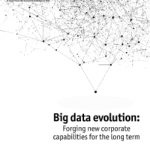 Time. It flies. It does so whether or not you’re having fun or otherwise putting it to good use. To know where it flies, you’d need to watch. But most of us can’t make the time to watch.
Time. It flies. It does so whether or not you’re having fun or otherwise putting it to good use. To know where it flies, you’d need to watch. But most of us can’t make the time to watch.
How we use time is important since it’s the one resource we can’t make more of. This often leads to the fight between now and later. In today’s fast-moving world, "now" is always a priority. This is especially challenging for enterprises working on complex initiatives such as big data quality, master data management, big data integration, data governance and the Internet of Things. This blog post examines why focusing on now inhibits us from achieving what we’d like to accomplish later.
“What is is the was of what shall be”
In those rare moments when we use now to think about what we need to accomplish later (i.e., when we use the present to predict the future), we have a tendency to imagine an end result that we would like to see happen without imagining how we will get there. Or, even more important, without imagining what we need to start doing now in order for later to become a reality.
Chapter 2 of the Tao Te Ching includes the phrase “what is is the was of what shall be.” (Please note: I have read eight different English translations of the Tao Te Ching, but I am quoting from possibly my all-time favorite, the “American poetic” translation by Witter Bynner).
In other words, today is the yesterday of tomorrow.
When we get to tomorrow, if we find that our prediction about the future didn’t come true, we usually blame it on what we didn’t accomplish yesterday. But since today is the yesterday of tomorrow, if we really want our prediction for tomorrow to come true, we better do what must be done today.
Now, of course, most of our predictions about the future are not about the near-future of tomorrow, but instead about a farther-future – be it next month, next quarter or next year.
All the same, what is is still the was of what shall be. And so every today must work toward the tomorrow of our prediction before today’s efforts are lost to another yesterday.
Predicting the future is about changing the present

Most predictions about the future describe a change that we would like to see happen. So predicting the future needs to combine a long-term goal with short-term goals, which are focused on changing the present. In their book, Switch: How to Change Things When Change Is Hard, Chip and Dan Heath explain that this requires the following two things to be clearly defined and effectively communicated:
- Long-term goal. What exactly is the change that we are going to make? What is our destination?
- Short-term critical moves. What are the first few things we need to do? How do we begin our journey?
“What is essential,” as the Heaths explain, “is to marry your long-term goal with short-term critical moves. What you don’t need to do is anticipate every turn in the road between today and the destination. It’s not that plotting the whole journey is undesirable; it’s that it’s impossible. When you’re at the beginning, don’t obsess about the middle, because the middle is going to look different once you get there. Just look for a strong beginning and a strong ending and get moving.”
What are your predictions for 2016?
It’s the time of year when we make predictions for the next year. What are your predictions for 2016? Is the fight between now and later preventing you from doing what you need to do today to make your predictions come true?
